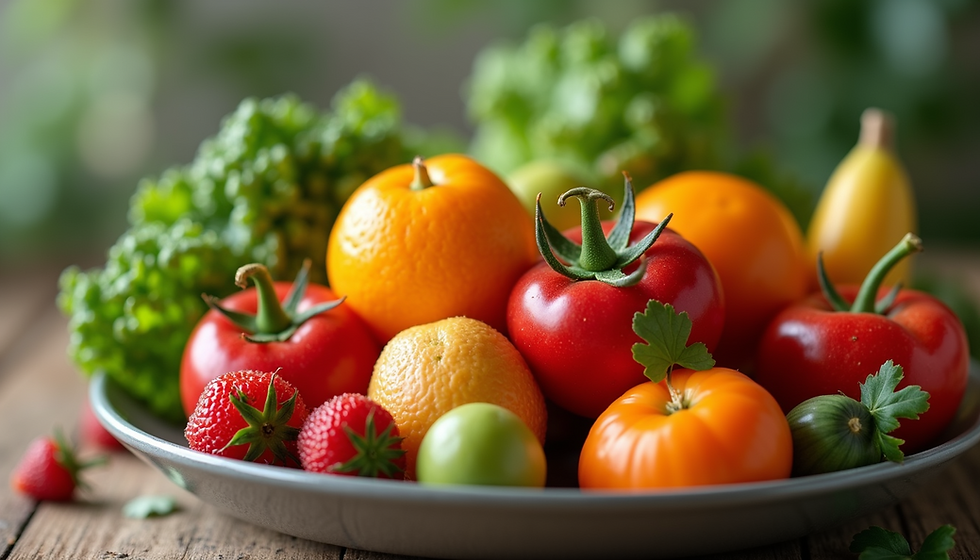My Journey to a Healthier Heart: Eat Smart, Live Strong
- eathappylife
- Jun 4
- 4 min read
As I began my journey toward better heart health, I quickly realized how crucial our food choices are. Heart disease is a leading health concern globally, affecting over 30% of adults. By making intentional choices, we can significantly reduce the risk of heart-related issues. Let's explore the best foods for a healthy heart and practical ways to add them to your daily meals!
Understanding Heart Health
To effectively improve heart health, it’s important to know the factors that contribute to heart disease. Genetics, lifestyle habits, and diet all play a critical role. Statistics reveal that about 80% of heart disease cases can be prevented through lifestyle changes. A diet filled with nutritious options can help curb the onset of heart disease and enhance overall wellness.
The Power of Whole Grains
One of my first steps was replacing refined grains with whole grains. Foods like brown rice, quinoa, and whole-grain bread are high in fiber, which can lower cholesterol levels. For example, studies show that increasing dietary fiber by 7 grams can reduce the risk of cardiovascular disease by up to 9%. Whole grains also help you feel fuller longer and provide essential nutrients for heart health.
Incorporating whole grains is straightforward. I started by choosing whole-grain bread over white bread and opting for brown rice instead of regular rice. These small swaps have notably boosted my energy and improved my heart health!
Fruits and Vegetables: Nature’s Medicine
Next on my list is a daily serving of fruits and vegetables! I discovered that various fruits and veggies are not just tasty—they are rich in antioxidants that combat heart disease. For instance, leafy greens like spinach and kale, along with colorful berries, are packed with vitamins and minerals essential for heart health.
In fact, research indicates that consuming 5 servings of fruits and vegetables daily is linked to a 20% lower risk of coronary heart disease. I've enjoyed creating vibrant salads, smoothies, and stir-fries that showcase the variety of colors and flavors nature offers. The more I diversify my produce, the more I appreciate how these foods contribute to my health!
Healthy Fats: The Good Kind
Although we often hear about limiting fats, healthy fats are actually beneficial! I learned to embrace fats from sources like avocados, nuts, and olive oil. These foods help lower bad cholesterol and combat inflammation, both vital for maintaining heart health.
For example, switching from butter to avocado on toast has not only improved my meals' nutritional profile but also added rich flavor. Cooking with olive oil instead of other fats has made a substantial difference in my heart-friendly recipes!
Legumes and Nuts: Protein Power
Legumes and nuts have become vital in my heart-healthy diet. Beans, lentils, and chickpeas offer excellent sources of protein and fiber—perfect substitutes for meat. In fact, a diet rich in legumes is associated with a 10% reduction in heart disease risk. Moreover, a handful of walnuts or almonds provides healthy omega-3 fatty acids that support heart function.
I frequently prepare hearty lentil soup or a chickpea salad as a filling meal. Nuts are also a great snack option—just a handful keeps my energy levels up throughout the day!
Fatty Fish: Marine Treasures
Fatty fish are another essential part of my journey. Salmon, mackerel, and sardines are abundant in omega-3 fatty acids, known to lower blood pressure and reduce the risk of heart disease. Eating fish twice a week is beneficial; studies have shown that people who regularly consume fatty fish reduce their heart disease risk by 36%.
Grilling salmon with a squeeze of lemon and herbs has become a staple for me. It’s a quick, delicious meal that’s also heart-healthy!
Spices and Herbs: Flavorful Allies
Incorporating spices and herbs into my cooking has minimized my sodium intake, which is crucial for heart health. Ingredients like turmeric, garlic, and cinnamon not only enhance flavor but also provide various health benefits.
Including garlic in my meals has become a regular practice because it can help reduce blood pressure by around 8-10%. Adding spices keeps my meals flavorful and interesting, all while supporting my heart!
🎥 Want to Learn the Real Science Behind Heart Health?
If you're ready to take control of your heart health — and discover how small diet changes can lead to big results — don’t miss this free educational video.
Hydration: Don’t Forget Your Water!
While we’ve focused heavily on food, staying hydrated is equally important! Drinking enough water supports overall health and ensures good blood flow and circulation. The American Heart Association recommends consuming at least 8 cups (64 ounces) of water daily for optimal heart function.
Since I began prioritizing hydration, I always carry a water bottle to track my intake. It’s amazing how much better I feel when I’m well-hydrated!
Your Path to a Healthier Heart
Starting this journey to a healthier heart has been incredibly rewarding. By integrating heart-healthy foods into my diet, I’ve noticed improvements in my physical and mental well-being.
Now, it’s your turn! Begin with small changes—such as replacing refined grains with whole grains or adding more fruits and vegetables to your plate. Every step counts in achieving a healthier heart!
Join me in embracing heart health one meal at a time, and let's inspire each other as we make choices that support our well-being.



Comments